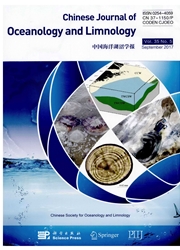

 中文摘要:
中文摘要:
一个泛音方法被用来分析在在 Bohai 海用 1996 ~ 2001 做的 11 个车站在夏天观察的潮流,中国。数据在不同仪器和间隔之中被比较。椭圆形的元素基于泛音常数,最大值的竖直分布,速度和旋转方向为理解特征被讨论被计算日报、半天潮流部件。结果显示 M2 潮流部件的最大的速度比 K1 的大得多;M2 潮流成分的旋转方向是顺时针方向在 Bohai 海的中央部分并且在 Laizhou 海湾,但是在 Liaodong 海湾和 Bohai 海湾逆时针方向。为 K1 潮流成分,它是顺时针方向在中央 Bohai 海但是在 Laizhou 海湾和 Liaodong 海湾逆时针方向。在在 Bohai 海的大多数车站的潮流是常规的除了那些半天在中央 Bohai 海,是不规则的半天。
 英文摘要:
英文摘要:
A harmonic method was used to analyze the tidal currents observed in summer at 11 stations made from 1996 to 2001 in the Bohai Sea, China. Data was compared among different instruments and intervals. Elliptic elements were calculated based on harmonic constants, of which vertical distributions of the maximum speed and rotation direction were discussed for understanding the characteristics of diurnal and semi-diurnal tidal current components. The results indicate that the maximum speed of M2 tidal current component is much larger than that of K1; the rotation direction of M2 tidal current constituent is clockwise in the central part of the Bohai Sea and in the Laizhou Bay, but anticlockwise in the Liaodong Bay and Bohai Bay. For K1 tidal current constituent, it is clockwise in the central Bohai Sea but anti-clockwise in the Laizhou Bay and Liaodong Bay. The tidal currents in most stations in the Bohai Sea were regular semidiurnal except for those in the central Bohai Sea, being irregular semidiurnal.
 同期刊论文项目
同期刊论文项目
 同项目期刊论文
同项目期刊论文
 期刊信息
期刊信息
